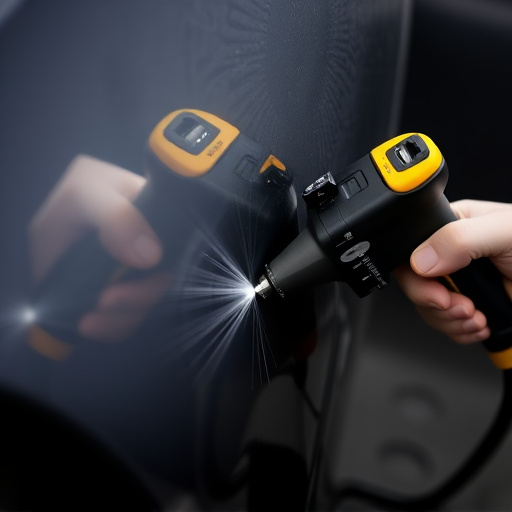Quality control inspections for airbags and ADAS are crucial to automotive safety. Trained technicians use standardized procedures and diagnostic tools to check every component, simulating collisions to find potential issues. Sensor testing ensures accurate data for airbag deployment, braking, and lane departure warnings. Real-world scenario simulations validate ADAS functionality, maintaining stringent safety standards.
In the automotive industry, ensuring safety is paramount, especially regarding airbag deployment, sensor functionality, and Advanced Driver Assistance Systems (ADAS). Quality Control Inspection (QCI) plays a pivotal role in verifying the integrity of these critical systems. This article delves into the intricacies of QCI protocols for airbags, sensor testing, and ADAS, highlighting the rigorous evaluation methods that guarantee their reliability and effectiveness in real-world scenarios. Understanding these processes is essential to maintaining the highest safety standards.
- Understanding Quality Control Inspection Protocols for Airbags
- Sensor Testing: Ensuring Critical Safety Features Function Properly
- Advanced Driver Assistance Systems (ADAS): Rigorous Evaluation Methods
Understanding Quality Control Inspection Protocols for Airbags

Quality control inspection protocols for airbags are a critical step in ensuring safety and reliability within the automotive industry. These rigorous processes are designed to detect any defects or malfunctions that could compromise the effectiveness of an airbag during a collision. At reputable car body shops and auto repair shops, trained technicians follow standardized procedures to inspect each component of the airbag system. This includes examining sensors, inflators, and deployment mechanisms for any signs of damage, corrosion, or malfunction.
During these inspections, experts closely scrutinize the integrity of the airbag material, verify proper sensor calibration, and ensure the inflator’s functionality. Advanced diagnostic tools are employed to simulate collision scenarios and evaluate the system’s response, thereby identifying potential issues that might go unnoticed during routine visual checks. By adhering to stringent quality control inspection standards, auto repair shops contribute to maintaining optimal safety standards in vehicles, safeguarding drivers and passengers alike.
Sensor Testing: Ensuring Critical Safety Features Function Properly

In a quality control inspection for Airbag, Sensor, and Advanced Driver-Assistance Systems (ADAS), meticulous sensor testing is paramount to guarantee critical safety features operate flawlessly. Sensors play a vital role in these systems by detecting potential hazards and initiating appropriate responses, making their functionality paramount. Through rigorous testing, inspectors can verify the accuracy and reliability of sensor data, ensuring that airbag deployment, braking assistance, and lane departure warnings function as designed under various conditions.
This testing involves simulating real-world scenarios, such as collision recreations and environmental simulations, to assess sensor performance in different situations. By subjecting sensors to these challenges, inspectors can identify any flaws or inconsistencies, allowing for timely repairs or replacements. It’s akin to performing dent repair on a car, where even the smallest misalignment can affect overall structural integrity. Similarly, automotive restoration techniques may be employed to refine sensor calibrations, ensuring they provide precise and consistent readings for optimal safety performance.
Advanced Driver Assistance Systems (ADAS): Rigorous Evaluation Methods

Advanced Driver Assistance Systems (ADAS) play a pivotal role in enhancing road safety by providing drivers with critical assistance and warnings. Ensuring their optimal performance requires meticulous quality control inspection processes. These systems, which include features like adaptive cruise control, lane-keeping assist, and collision avoidance, are subject to rigorous evaluation methods. Each component, from sensors to airbag deployment mechanisms, undergoes stringent testing to meet stringent safety standards.
Quality control inspections for ADAS involve a multi-step process that simulates real-world scenarios. This includes validating sensor accuracy in varying weather conditions, simulating automotive collision repair situations to check airbag deployment effectiveness, and evaluating system responsiveness during critical driving maneuvers. The goal is to identify and rectify any defects or malfunctions early in the manufacturing stage, ensuring passengers’ safety and peace of mind on the road.
Quality control inspection plays a vital role in ensuring the safety and reliability of airbags, sensors, and Advanced Driver Assistance Systems (ADAS). By implementing rigorous testing protocols, manufacturers can identify and rectify defects early on, enhancing passenger security. Through meticulous sensor testing and comprehensive ADAS evaluation, these inspections safeguard drivers and passengers alike, making our roads safer. A robust quality control process is the cornerstone of a well-protected automotive ecosystem.













